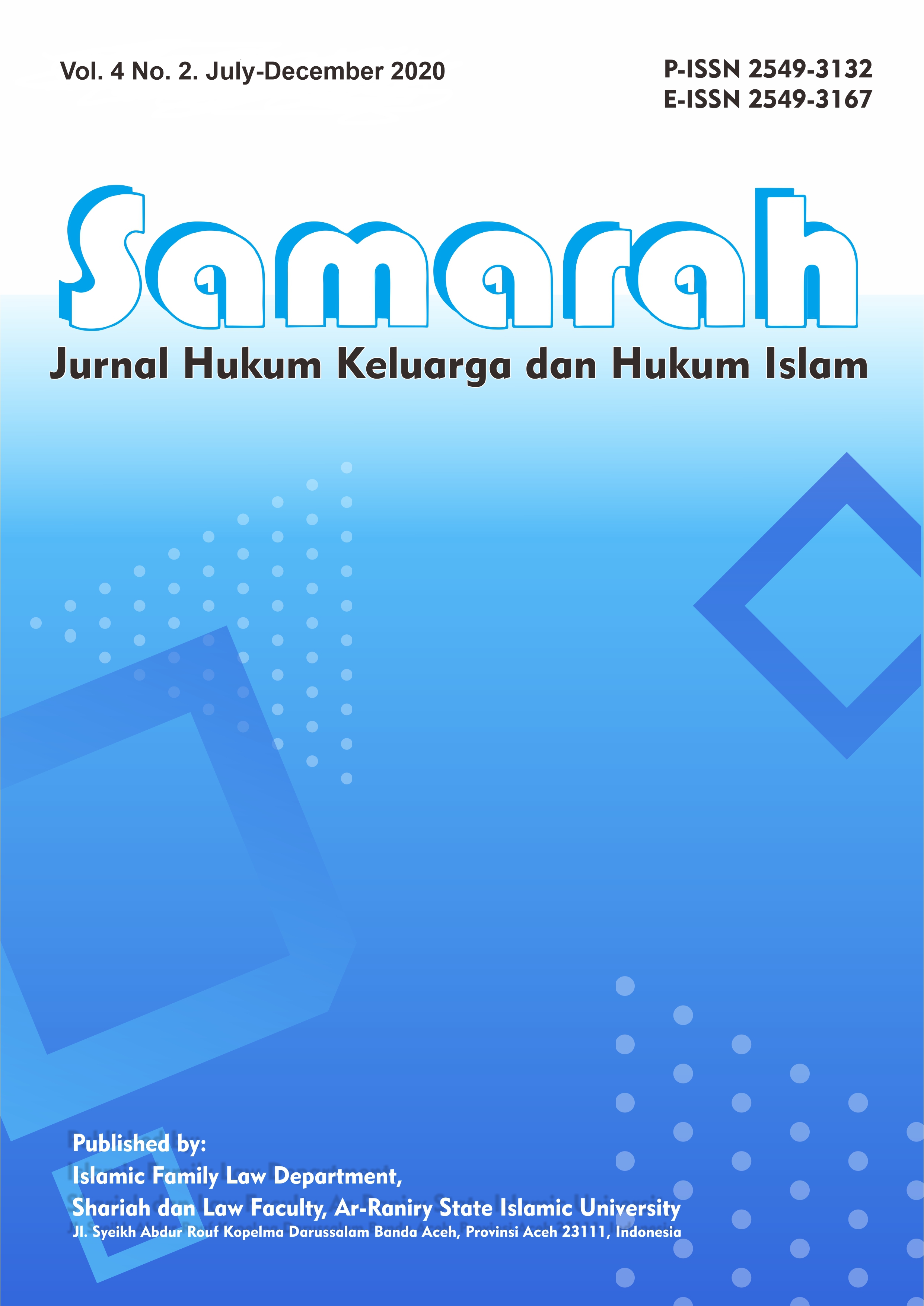Reconstruction of the Concept of Nushuz of the Wife in the Digital Era
DOI:
https://doi.org/10.22373/sjhk.v4i2.7259Keywords:
reconstruction, nushuz of wife, digital eraAbstract
The increasing number of divorces has been largely affected by technological developments, including social media, which are used in a way that may lead wives to commit nushuz behavior. This present study aimed at reconstructing the nushuz of the wife in the digital era, a concept commonly known as the wife leaving her house without the permission of the husband. As a normative study, the study applied the conceptual approach. The study collected data by using the documentation study or library research, and analyzed the data by reading, examining, linking, and interpreting the data, and then elaborated the data descriptively. The findings revealed that social media has been used as a platform to publicly show the women’s beauty, reveal their aurat (intimate parts), spread gossips, share infidelity behavior, and many others which violate the religious norms and the universal, collective, individual, local and traditional values as well. Ideally, all of these should be kept private at home, as the home itself is the place to protect anything within it. The elimination of politeness boundaries and rules of interaction between men and women as a consequence of activities on social media has made nushuz of the wife irrelevant to be interpreted simply as the wife leaving the house without the permission of the husband. The meaning of house in the physical sense and that of social media should be equal in the context of the household. Nushuz should be interpreted in a broader perspective following the increasing development of modern technologies.
References
Abdul Rohman, Dudung, Mengembangkan Etika Berumah Tangga Menjaga Moralitas Bangsa Menurut Pandangan Al-Qur’an, Bandung: Nuansa Aulia, 2006.
Abu Zharah, Muhammad, Tarikh Al-Madhahib Al-Islamiyyah Al-Juz’u Al-Thani Fi Tarikh Al Madhahib Al-Fiqhiyyah, Cairo: Dar Al-Fikr Al-Araby.
Ahmad Fauzi, “Pakaian Wanita Muslimah Dalam Perspektif Hukum Islam”, Jurnal Iqtishodia, Vol. 1, No. 1 (2016)
Al-Jaziry, Abdurrahman, Kitab Al Fiqh ‘Ala Al-Madhahib Al-Arba’ah, Beirut: Dar Al-Kutub Al-Ilmiyyah, 2002.
At-Thabari, Jamiu Al-Bayan Li Ta’wili Ayi Al-Qur’an, Damascus: Darul Al-Kutub Al-Islamiyah.
Dahlan, Abdul Aziz, et al, Ensiklopedi Hukum Islam, Jakarta: Ichtiar Baru Van Hoeve, 1996.
Jawad Mughniyah, Muhammad, Lima Mazhab, Jakarta: Lentera, 2002.
Michael A Hitt, et al., Manajemen Strategi Menyongsong Era Persaingan dan Globalisasi, Jakarta: Erlangga, 1996.
Musa, Kamil, Suami Istri Islam, Bandung: Remaja Rosda Karya, 1980.
Nasution, Khoiruddin, Islam Tentang Relasi Suami dan Istri (Hukum Perkawinan I), Yogyakarta: Academia, 2004.
Nor Salam, Konsep Nushuz Dalam Perspektif Al-Qur’an (Sebuah Kajian Tafsir Maudhu’i), Jurnal syariah dan Hukum, Vol.7, No. 1, (2015)
Raid bin Shabri ibn Abi Ulfah, Syuruh Sunan Ibn Majah, Juz 2, Jordan: Baitul Afkar, 2007.
Rasyid, Sulaiman, Fiqih Islam, Jakarta: At-Thariyah, 2018.
Ritzer, et al., Teori Sosiologi Dari Teori Sosiologi Klasik Sampai Perekembangan Mutakhir Teori Sosial Postmodern, Yogyakarta: Kreasi Wacana, 2008.
Taimiyah, Ibnu, Majmu’aha Al-Fatwa, Egypt: Dar Al Wafa, 1998.
Taqiyu Ad-Din Abi Bakr Ibn Muhammad Al-Husaini Ad-Dimasqi, Kifayat Al-Akhyar, Beirut, Dar Al-Fikr, 1996.
Usman, Suparman, Hukum Islam: Asas-Asas Dan Pengantar Studi Hukum Islam Dalam Tata Hukum Islam, Jakarta: Gaya Media Pratama, 2002.
Yasid, Abu, Fiqih Realitas: Respon Ma’had Aly Terhadap Wacana Hukum Islam Kontemporer, Yogyakarta: Pustaka Pelajar, 2005.
Loka data, https://lokadata.beritagar.id/chart/preview/7-provinsi-dengan-angka-perceraian-tertinggi-2016-1510649700, (November 16, 2019).
Bhsafm.co.id, https://www.bhasafm.co.id/pemerintahan/teknologi-informasi-penyebab-tingginya-perceraian-di-situbondo-1-129-pasutri-bercerai-karena-tak-harmonis/, (October 25, 2019).
Detik.com, https://news.detik.com/berita/4329410/gara-gara-medsos-perceraian-pasangan-muda-di-makassar-meningkat, (25 Oktober 2019).
https://www.syariahislam.com/hukum-istri-keluar-rumah-tanpa-izin-suami/, (April 7, 2020)
http://repository.uin-suska.ac.id/334/, (October 29, 2019)
http://repository.uin-suska.ac.id/17389/, (October 29, 2019)

Downloads
Published
Issue
Section
License
Authors who publish in Samarah: Jurnal Hukum Keluarga dan Hukum Islam agree to the following terms:
- Authors retain copyright and grant the journal right of first publication with the work simultaneously licensed Attribution-ShareAlike 4.0 International (CC BY-SA 4.0) that allows others to share the work with an acknowledgment of the work's authorship and initial publication in this journal.
- Authors are able to enter into separate, additional contractual arrangements for the non-exclusive distribution of the journal's published version of the work (e.g., post it to an institutional repository or publish it in a book), with an acknowledgment of its initial publication in this journal.
- Authors are permitted and encouraged to post their work online (e.g., in institutional repositories or on their website) prior to and during the submission process, as it can lead to productive exchanges, as well as earlier and greater citation of published work. (See The Effect of Open Acces)








